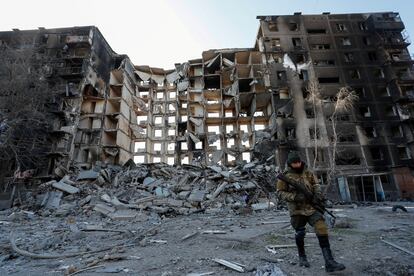Mayor of Mariupol Vadym Boychenko: ‘We should have done more. We didn’t ask Kyiv for help’
The occupied city’s de jure leader puts the civilian death toll from the siege at 22,000 and says they were not prepared for the scale of the assault: ‘We did not know the Russians were advancing towards us’

The Russian conquest of Mariupol, one of the bloodiest battles of the Ukraine war and the first significant strategic victory secured by the Kremlin, caught Ukraine off guard according to the city’s de jure mayor, Vadym Boychenko, who told EL PAÍS during an interview in Kyiv last Thursday that a lack of preparation and resources, as well as overconfidence, remain the “big questions” that will have to be addressed “after the war.”
Boychenko, 45, has been performing his duties in exile after escaping Mariupol 48 hours after Moscow launched its invasion of Ukraine on February 24, 2022. Details of how the disaster unfolded remain fresh in his mind and recalls the intricacies of negotiations at the international level to try to evacuate the population and thwart Vladimir Putin’s plans. Boychenko’s grandmother, who did not recover from injuries she sustained during a Russian bombardment, is one of the of the thousands of fatalities caused by the battle for the city. Today, Mariupol is a city in ruins where - according to the reconstruction plan presented last month and baptized “Rebirth” - 41% of all residential buildings are destroyed and 90% of the city’s infrastructure has been damaged. The economic toll is estimated at $14.5 billion.
Boycheno says Russian troops arrived “like tourists” from the Crimean Peninsula, illegally annexed by Russia in 2014 and around 250 miles from Mariupol. “All our defenses were concentrated in the eastern part of the city, where their army was expected to arrive. You never anticipate that, when you go to confront the enemy, it will arrive from behind.” As such, when the invasion began, the western side of this industrial city on the Sea of Azov, which had around 540,000 inhabitants before the war, was left unguarded. This allowed Russian forces to surround Mariupol within a few days and pound it relentlessly with artillery. When Mariupol finally fell, almost three months later, its population had been reduced to 90,000, “almost all of them elderly people” with hardly any access to water, electricity, or gas.
Between last May to now, that number has risen to about 150,000 people, Boychenko estimates. Around 20,000 of these, he says, form part of a resistance network, which is essential to for gathering information and support from inside the when the expected counter-offensive arrives. In the meantime, some 120,000 residents of Mariupol remain outside Ukraine with another 150,000 spread across other regions of the country. This disparity in numbers leads Boychenko to believe that the local authority’s estimates of 22,000 civilians killed during the city’s defense is low.

“Everything happened very quickly,” Boychenko recalls. It was not until February 24 that the city began to fortify its western neighborhoods; four days later, Mariupol was completely surrounded; on March 1 and 2, Russian troops tried unsuccessfully to enter the city; on March 3, artillery bombardments intensified; on March 9, the first attack with bomber aircraft took place and the maternity hospital was hit, sending shockwaves around the world; shortly afterward, warships of the Russian Black Sea fleet joined the attack.
“Looking back on those events, we have the feeling that we should have done more. But on February 24, we were not aware of what would happen the next day, or the next... I did not know that the border with Crimea did not really exist anymore, and that the Russians were advancing towards us. I was not informed about this,” Boychenko explains. That is why, he admits: “We didn’t ask Kyiv for help and did everything the military asked us to do. We only started shouting for help when the city was already surrounded and the Russian Federation had started destroying Mariupol. Nobody stopped them.”
As the Russians advanced, the national authorities give the mayor the order to withdraw as a target for the invading forces. “If I ignored the order and stayed, I would be considered a [pro-Moscow] traitor,” he says of that decision, although he announced on February 24 he would remain in the city. Like many other mayors in the occupied zone, Boychenko carries out his mandate from a distance while puppet administrations installed by Moscow appoint their own municipal teams.
Boychenko acknowledges he has no military experience and he placed himself in the hands of those that did. He appointed an experienced deputy to help and held face-to-face meetings with his team and via video link with the office of President Volodymyr Zelenskiy in Kyiv. He also met with the commanders of the Azov battalion, who defended the Azovstal steelworks to the last as Russian forces closed in. He also held two press conferences to urge citizens to flee on trains provided free of charge.
However, at the time nobody had gauged the scale of the Russian assault. “That is why, unfortunately, those trains left half-empty,” says Boychenko. There was an atmosphere of confidence in Mariupol that belied what was to come. “Why did people, and I personally, not expect something terrible and did not believe that Putin would order the destruction of the city and kill thousands of people? Because in 2014, the city was occupied by Russia for two months and there was no army and there was no destruction.”

On this occasion, Moscow was prepared to subdue the city with an unprecedented degree of savagery, which many people attribute to the failed attempt in 2014 to conquer Mariupol. Boychenko estimates that only about 100,000 people had departed before the siege and evacuation convoys during the first days of the invasion were turned back at Russian checkpoints. “We had 100 new, modern buses, already filled with fuel, ready and with drivers. At three locations inside the city, we gathered thousands of people who wanted to leave. They told us that they would open the city and let us leave. But unfortunately, this did not happen,” says Boychenko, whose number two inside the city organized the effort.
Negotiations in the international sphere to try to prevent the deaths of civilians multiplied. “On March 3, [US] Secretary of State [Antony] Blinken contacted me personally and said that something had to be done.” On the same day, Zelenskiy “gave the order to create a group to manage the evacuation of civilians.” Amid of an increasingly heated atmosphere, Turkey hosted the highest-level meeting during the first two weeks of the invasion between the foreign ministers of Ukraine and Russia, Dmytro Kuleba and Sergey Lavrov: but it ended without an agreement to open a humanitarian corridor in Mariupol.
Boychenko says he was in constant contact with Kuleba. “Lavrov said he had no authority to make decisions about Mariupol. So, I thought, it is clearly Putin who is making the decisions and looked for people to pressure for the opening of the city. We were lobbying [Emmanuel] Macron, [Recep Tayyip] Erdogan and the Pope.” It was not until mid-March, in dribs and drabs, that the population of Mariupol began to pass through the Russian checkpoints. This corridor allowed approximately another 100,000 people to leave the city. But the attacks did not let up and on March 16 the Mariupol Theater building was bombed. Several thousand residents were sheltering there and, according to an investigation by the Associated Press agency, some 600 people were killed.
The de jure mayor gives short shrift to the rebuilding plan the pro-Russian authorities have put in place: he believes it is nothing more than an attempt to erase the trail of possible war crimes. “The price paid by Mariupol was not paid by other cities. Mariupol tied down the enemy and gave other cities and our Armed Forces time to prepare. And most importantly, Mariupol gave us faith that we can defeat this enemy.” Boychenko is optimistic that Ukraine is preparing a counter-offensive for the end of April or early May, and then his administration can push forward with its own Rebirth reconstruction project. “This year Mariupol will be liberated; this is what we are preparing for.”
Sign up for our weekly newsletter to get more English-language news coverage from EL PAÍS USA Edition
Tu suscripción se está usando en otro dispositivo
¿Quieres añadir otro usuario a tu suscripción?
Si continúas leyendo en este dispositivo, no se podrá leer en el otro.
FlechaTu suscripción se está usando en otro dispositivo y solo puedes acceder a EL PAÍS desde un dispositivo a la vez.
Si quieres compartir tu cuenta, cambia tu suscripción a la modalidad Premium, así podrás añadir otro usuario. Cada uno accederá con su propia cuenta de email, lo que os permitirá personalizar vuestra experiencia en EL PAÍS.
¿Tienes una suscripción de empresa? Accede aquí para contratar más cuentas.
En el caso de no saber quién está usando tu cuenta, te recomendamos cambiar tu contraseña aquí.
Si decides continuar compartiendo tu cuenta, este mensaje se mostrará en tu dispositivo y en el de la otra persona que está usando tu cuenta de forma indefinida, afectando a tu experiencia de lectura. Puedes consultar aquí los términos y condiciones de la suscripción digital.
More information
Archived In
Últimas noticias
The metaverse, four years later: Is it finished or just at a standstill?
$3,000 and a plane ticket: The United States increases incentives for migrants to self-deport before the end of the year
Charles Dubouloz, mountaineering star, retires at 36 with a farewell tour inspired by Walter Bonatti
From the White House to diplomatic gifts: Lego wins over adult fans, brick by brick
Most viewed
- The low-cost creative revolution: How technology is making art accessible to everyone
- Christian Louboutin: ‘Young people don’t want to be like their parents. And if their parents wear sneakers, they’re going to look for something else’
- All the effects of gentrification in one corner of Mexico’s Colonia Roma
- Christmas loses its festive spirit: ICE fears cast shadow over religious celebrations
- Liset Menéndez de la Prida, neuroscientist: ‘It’s not normal to constantly seek pleasure; it’s important to be bored, to be calm’










































